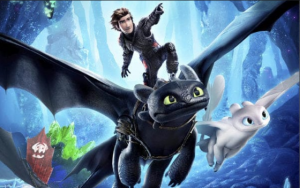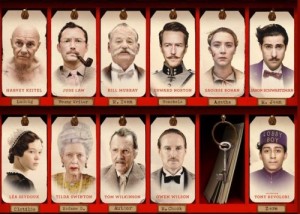HOW TO TRAIN YOUR DRAGON: THE HIDDEN WORLD: 4 STARS. “satisfying franchise finale.”
 IMDb lists dozens of titles containing the phrase “dragon slayer.” The Hobbit author J.R.R. Tolkien described dragon Smaug as “a most specially greedy, strong and wicked worm.” The Flight of the Conchords have a song called “Albi the Racist Dragon,” and on Dragon Day at Cornell University, an effigy of one of the giant beasts is burned while students shout and dance.
IMDb lists dozens of titles containing the phrase “dragon slayer.” The Hobbit author J.R.R. Tolkien described dragon Smaug as “a most specially greedy, strong and wicked worm.” The Flight of the Conchords have a song called “Albi the Racist Dragon,” and on Dragon Day at Cornell University, an effigy of one of the giant beasts is burned while students shout and dance.
From “Game of Thrones” to “DragonHeart” the winged creatures are portrayed as fiery, fearsome creatures. Only one movie franchise shows the flip side, cinematic dragons who are more misunderstood than actually evil. “How to Train Your Dragon: The Hidden World” is the final instalment of the wildly successful trilogy of tales about a dragon whisperer and his flying pet.
Hero Hiccup (voice of Jay Baruchel), now the chief of the dragon-friendly Viking Isle of Berk, and his fire-breathing friend Toothless are growing up. Romance is in the air. Hiccup may or may not propose to Astrid (America Ferrera) while Toothless falls for a Light Fury, a smaller dragon whose colouration allows her to hide in clouds.
All is well until Grimmel (F. Murray Abraham), a dragon hunter whose goal is to exterminate all dragons, disrupts Berk’s romantic idylls. As Grimmel’s dark threat hangs over Berk, Hiccup searches for a safe haven for both dragons and Vikings, the fabled Hidden World. “I don’t see a way of staying here any longer,” he says. “If we want to live in peace with our dragons we need to disappear off the map.”
The “How to Train Your Dragon” movies have always been cinematic. Director Dean DeBlois’s camera is in constant motion capturing the choreography of flocks of dragons as they soar through the air or Hiccup’s more outlandish adventures. “The Hidden World” is no different. Beautifully animated, it makes the most of its visuals, presenting gorgeous landscapes of Berk and the beautiful phosphorescent caves of the Hidden World that feel like they sprang from the pages of one of Cressida Cowell source novels.
The dragons come in all shapes, sizes and colours. From fierce to funny they each have distinct personalities. The mating dance between Toothless and the Light Fury is goofy, sweet fun, like something out of a NatGeo documentary on dragon rituals. DeBlois’s animators have found new and subtle ways to add expression to their scaly faces that helps bring them to vivid life.
There is less story in “The Hidden World” than the previous franchise entries. There are good messages about selflessness, the importance of love—the old chestnut about loving something enough to set it free is emphasized—topped off by more timely ideas about finding ways to co-exist.
The goofy humour that gave the other films much of their charm is intact but the emphasis is placed on large-scale action sequences and set pieces. The characters have grown up and so has the action. Dragons spew green acid and the swashbuckling is frenetic which may be too much for younger viewers.
“How to Train Your Dragon: The Hidden World” feels like a film that has grown along with its core audience. Determined to supply a satisfying ending to the franchise DeBlois delivers a movie that pushes the boundaries of the series while still maintaining the soul that earned the fans in the first place.


